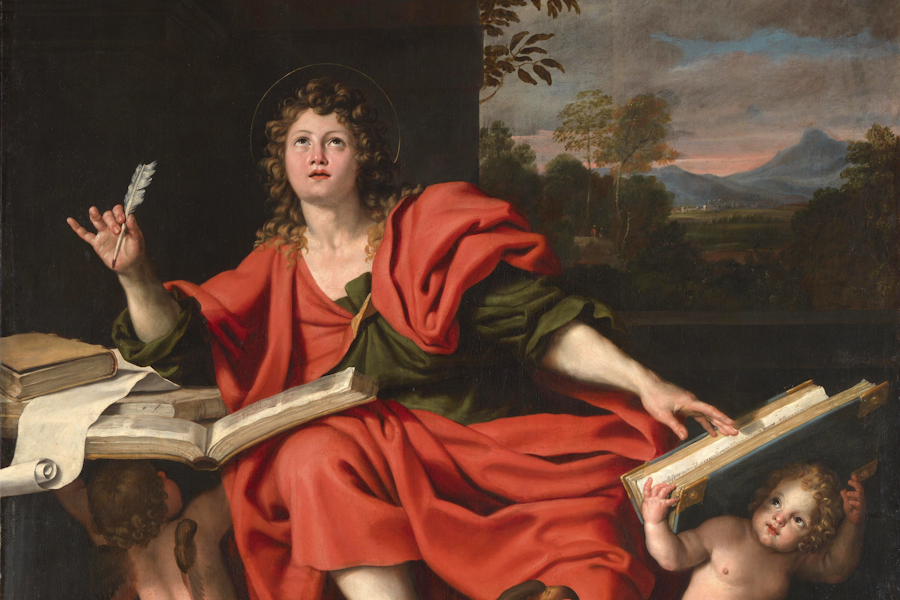Introductory Note:
In response to the shocking realization that she had approached Bible history as make-believe in her younger years, Dorothy Sayers (1893-1957) penned this essay to help jar readers out of a fairy-tale approach to reading scripture. She writes:
I think it was chiefly Cyrus and Ahasuerus who prodded me into the belated conviction that history was all of a piece, and that the Bible was part of it. …
Most children, I suppose, begin by keeping different bits of history in watertight compartments, of which the Bible is the tightest and most impenetrable. But some people seem never to grow out of this habit — possibly because of never having really met Cyrus and Ahasuerus (or Xerxes). Bible critics in particular appear to be persons of very leisurely mental growth. Take, for example, the notorious dispute about the Gospel according to St. John.
Into the details of that dispute I do not propose to go. I only want to point out that the arguments used are such as no critic would ever dream of applying to a modern book of memoirs written by one real person about another.
Sayers then imagines what such a review of John’s gospel would look like. She says, “Let us pretend for a moment that Jesus is a real person who died within living memory, and that John is a real author, producing a real book.” Of course, Sayers assumes the Christian reader is not pretending, or at least professes to believe that these things are true! It’s her brilliant way of pointing out the “taint of unreality” that sometimes creeps into our reading of the written Word. “Saying we believe a thing does not make it so,” Dallas Willard was fond of reminding people. Sometimes we need creative thinkers like Dorothy Sayers to help us see the places where our actual faith lags behind our well-formed doctrines ... and to give us fresh encounters with the story that help bridge the gap.
Grace Pouch
Content Manager
Let us pretend for a moment that Jesus is a real person who died within living memory, and that John is a real author, producing a real book; what sort of announcement shall we look for in the literary page of an ordinary newspaper? Let us put together a brief review, altering some of the names a little to prevent that Bible feeling.
Memoirs of Jesus Christ. By John Bar-Zebedee; edited by the Rev. John Elder, Vicar of St. Faith’s, Ephesus. (Kirk, 1978.)
The general public has had to wait a long time for the intimate personal impressions of a great preacher, though the substance of them has for many years been familiarly known in Church circles. The friends of Mr. Bar-Zebedee have frequently urged the octogenarian divine to commit his early memories to paper; this he has now done, with the assistance and under the careful editorship of the Vicar of St. Faith’s. The book fulfills a long-felt want.
Very little actually has been put in print about the striking personality who exercised so great an influence upon the last generation. The little anonymous collection of “Sayings” by “Q” is now, of course, out of print and unobtainable. This is the less regrettable in that the greater part of it has been embodied in Mr. J. Mark’s brief obituary study and in the subsequent biographies of Mr. Matthews and Mr. Lucas (who, unhappily, was unable to complete his companion volume of the Acts of the Apostles). But hitherto, all these reports have been compiled secondhand. Now for the first time comes the testimony of a close friend of Jesus, and, as we should expect, it offers a wealth of fresh material.
With great good judgment, Mr. Bar-Zebedee has refrained from going over old ground, except for the purpose of tidying up the chronology that, in previous accounts, was conspicuously lacking. Thus, he makes it plain that Jesus paid at least two visits to Jerusalem during the three years of His ministry — a circumstance that clears up a number of confusing points in the narrative of His arrest; and the two examinations in the ecclesiastical courts are at last clearly distinguished. Many new episodes are related: in particular, it has now become possible to reveal the facts about the mysterious event at Bethany, hitherto discreetly veiled out of consideration for the surviving members of the Lazarus family, whom rumor had subjected to much vulgar curiosity and political embarrassment.
But the most interesting and important portions of the book are those devoted to Christ’s lectures in the temple and the theological and philosophical instructions given privately to his followers. These, naturally, differ considerably in matter and manner from the open-air “talks” delivered before a mixed audience, and shed a flood of new light, both on the massive intellectual equipment of the preacher and on the truly astonishing nature of his claim to authority. Mr. Bar-Zebedee interprets and comments upon these remarkable discourses with considerable learning and with the intimate understanding of one familiar with his master’s habits of thought.
Finally, the author of these memoirs reveals himself as that delightful rara avis, a “born writer.” He commands a fine economy and precision in the use of dialogue; his character sketches (as in the delicate comedy of the blind beggar at the Pool of Siloam) are little masterpieces of quiet humor, while his descriptions of the meal in the upper room, the visit of Simon Bar-Jonah and himself to the sepulcher, and the last uncanny encounter by the Lake of Tiberias are distinguished by an atmospheric quality that places this account of the Nazarene in a category apart.
How reasonable it all sounds, in the journalese jargon to which we have grown accustomed! And how much more readily we may accept discrepancies and additions when once we have rid ourselves of that notion “the earlier, the purer,” which, however plausible in the case of folklore, is entirely irrelevant when it comes to real biography. Indeed, the first life of any celebrity is nowadays accepted as an interim document. For considered appreciation we must wait until many contemporaries have gone to where rumor cannot distress them, until grief and passion have died down, until emotion can be remembered in tranquility.…
But the root of the trouble is to be found, I suspect (as usual), in the collapse of dogma. Christ, even for Christians, is not quite really real — not altogether human — and the taint of unreality has spread to his disciples and friends and to his biographers; they are not “real” writers, but just “Bible” writers. John and Matthew and Luke and Mark, some or all of them, disagree about the occasion on which a parable was told or an epigram uttered. One or all must be a liar or untrustworthy because Christ (not being quite real) must have made every remark once and once only. He could not, of course, like a real teacher, have used the same illustration twice, or found it necessary to hammer the same point home twenty times over, as one does when addressing audiences of real people and not of Bible characters.… But these considerations would, of course, apply only to real people.
Adapted from “ ‘A vote of thanks to Cyrus,” in Whimsical Christian: 18 Essays by Dorothy L. Sayers, 1987, Collier Books.
Image: Zampieri Saint John the Evangelist by Domenichino, circa 1620s. National Gallery London. Public domain.
Text First Published March 1987 · Last Featured on Renovare.org November 2023


